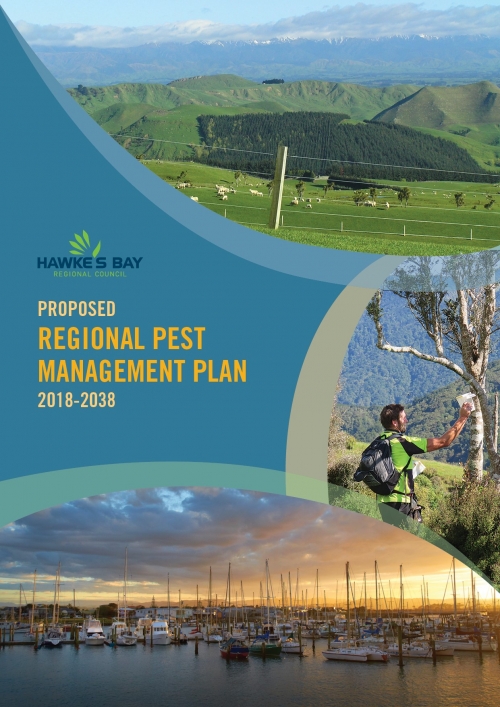I want to...
Current filter: Most popular
A to Z
Apply for a job
Biosecurity
Consents
Consultation
Contact Us
Environmental Data
Farmers Hub
Fix it or Report it
Information Request
Join an Event
Leasehold Land
Meetings
Rates
Water Metering
Have Your Say
Pest Management Changes Proposed for Hawke's Bay
Published: 7 February 2018

Changes to the way pest management is approached in Hawke’s Bay are in the Proposed Regional Pest Management Plan 2018-2038 which has been approved for consultation by Hawke’s Bay Regional Council.
The proposed plan has been developed by Regional Councillors and staff working with key stakeholders and interested groups, including the horticulture and agriculture sector, Department of Conservation, council, iwi and members of the community. The current pest management strategies were reviewed and changes made to meet new demands and legislative requirements.
The Proposed Regional Pest Management Plan is open for public consultation from 2 February to 16 March 2018. Accompanying the proposed plan is a cost benefit analysis and cost allocation report. These can be viewed and downloaded here.
And submissions can be made here.
A discussion document was issued in May 2017 seeking feedback on pest management and highlighting key proposals for change. Over 90 submissions were received on the discussion document which has helped shape the proposed plan.
“Our Pest Management Plan is hugely important to the region, delivering both economic benefit to farmers and advancing our biodiversity goals,” Cr Tom Belford, Chairman of the Environment and Services Committee.
Submissions from both urban and rural people are welcome before the consultation period closes on Friday 16 March 2018. People who submitted on last year’s discussion document are being approached directly to request their further input.
Major changes in the proposed plan are -
- Inclusion of marine pest management programme. Since 2009, the number of non-indigenous species in New Zealand has risen by 10 percent, with 33 new species recorded between 2010 and 2015. Currently there are only two known marine pests in Hawke’s Bay: Asian kelp (Undaria pinnatifida) and Australian tubeworm (Ficopomatus enigmaticus). A marine rule has been added to the plan requiring all vessels entering Hawke’s Bay waters to be clean of biofouling to prevent these pests becoming established. Hawke’s Bay Regional Council staff recently cleared a reef build-up of Australian tubeworm in the Ahuriri Estuary that was affecting tidal flow and biodiversity.
“It is a lot more cost effective to attempt to prevent invasive species entering our region than it is having to control them,” says Cr Belford.
- Reduction of the catch trap (RTC) rate in Possum Control Areas from 5% to 4%. That is a measure of the number of possums trapped in monitoring runs – the aim is to have only 4 traps in 100 or fewer catching a possum. This is a reflection of the success of the regional possum control area programme in continuing to keep possum numbers low.
“We are currently tracking at 2.5% across the entire possum control area programme which is a huge success. Reducing the RTC will help detect problem areas faster and is heading in the right direction for Predator Free Hawke’s Bay,” Cr Belford.
- Addition of a ‘good neighbour’ rule for possums, matching the trap catch rate change. Possums will need to be controlled to 4% RTC within 500m of a boundary of a neighbouring property where a possum control operation is in place.
- Addition of another ‘good neighbour’ rule for feral goats. This requires responsible management of goats within 500m of a neighbouring property where that property is actively managing feral goats to protect native plantings or biodiversity values. In Hawke’s Bay, feral goats are considered a pest but are also managed as an economic resource so the plan takes a balanced, pragmatic approach to landowners’ needs.
“Feral goats represent a major threat to the increased riparian planting and afforestation initiatives that are being contemplated for the region. Councillors are treating this as a high priority,” emphasised Cr Belford.
- Addition of wallabies as an exclusion pest. These are found in neighbouring regions.
- Addition of 6 pest plant species to an exclusion programme, with the aim of preventing them establishing in the Hawke’s Bay region - Noogoora bur, Yellow bristle grass, Alligator weed, Marshwort, Senegal tea, Spartina. These are currently not found in Hawke’s Bay. Cathedral bell and Darwin’s barberry which are in the region have also been included in the plan for the first time.
Disclaimers and Copyright
While every endeavour has been taken by the Hawke's Bay Regional Council to ensure that the information on this website is
accurate and up to date, Hawke's Bay Regional Council shall not be liable for any loss suffered through the use, directly or indirectly, of information on this website. Information contained has been assembled in good faith.
Some of the information available in this site is from the New Zealand Public domain and supplied by relevant
government agencies. Hawke's Bay Regional Council cannot accept any liability for its accuracy or content.
Portions of the information and material on this site, including data, pages, documents, online
graphics and images are protected by copyright, unless specifically notified to the contrary. Externally sourced
information or material is copyright to the respective provider.
© Hawke's Bay Regional Council - www.hbrc.govt.nz / +64 6 835 9200 / info@hbrc.govt.nz


